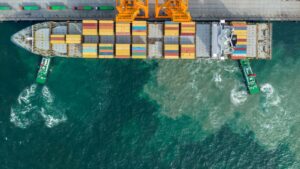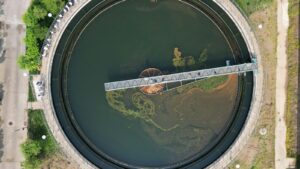Plastics Crisis: Quantifying Data for Transparency
By 2050, the weight of all the plastic in our oceans could exceed the weight of all its fish, according to estimates made by The Ellen MacArthur Foundation. In 2017, only 14% of plastic packaging was recycled, representing $80–120 billion in lost value. These hold-your-head-in-your hands figures tell us that corporates, governments and consumers are in the dark about a number of questions. Where is all the plastic waste? How much of it, exactly, is there? What happens to it? And most importantly, what is being done about it?
At present, most data on plastics comes from Material Recovery Facilities (MRF) which is measured in bails per month and by material used. With current data, estimates of recycling rates by county or country are possible but the data does not go much further than that. As a result, waste crime is high and meaningful actions to improve services and systems are ill-informed.
Attractiveness
Technology is starting to enable smarter, more detailed data capture, as well as aggregation and analysis. Between 2019-2025, the smart waste market is expected to reach $3.97 billion, at a CAGR of 16.6%. According to NYU Stern’s Centre for Sustainable Business, 50% of the growth in consumer-packaged goods was from sustainably marketed products (between 2013 -2018). Meanwhile, the sad reality is that plastic pollution is accelerating at an unsustainable pace.
Business models
Technologies have emerged to better track plastic throughout its lifecycle. On a broad scale, geospatial analytics and AI can map waste streams, while unique codes, UV tags, blockchain, mobile apps, smart bins and MRF scanners are tracking waste flows on a granular level.
The key drivers for tracking waste
1. Regulation – New plastic bans (currently on hold due to COVID-19) and proposed Extended Producer Responsibility (EPR) policies from the EU, UK and the US encourage corporates to take voluntary action to hold themselves accountable for the waste they produce ahead of top-down policies.
2. Waste Crime – Governments are seeking solutions to track waste streams, provide transparency and hold corporations or individuals accountable.
3. Improve end-of-life options – Waste managers across the value chain want to better understand waste streams so actions to reduce, reuse or recycle plastics are effective.
4. Reducing contamination – MRFs cannot guarantee the quality of recycled plastic waste recovered, therefore plastic is undervalued. More granular tracking enables better sorting throughout the value chain, reducing contamination; additionally, aggregated data can guarantee bail quality.
5. New business models – Many of the corporates that we have spoken to plan for their technologies to be a springboard for new business models. Some of the emerging business models in plastic tracking include aggregated data set analysis, reverse logistic services, corporate partnerships and incentive schemes.
Start-ups are selling subscriptions as SaaS (software as a service) packages such as Topolytics, a developer of data aggregation and analytics software that combines AI, geospatial analysis and current data inputs (e.g. materials pricing and permitting) to track waste streams and build a higher level of confidence in waste data. The company’s WasteMap platform is used by corporate waste producers, the recycling industry, investors and regulators to generate insights into the ‘downstream materials’ system. In October 2019, on behalf of UK environmental regulators, they partnered with the Ordnance Survey, Google Cloud and SAP to create a system to digitally track all 500 million waste movements across the UK. Within this project, Topolytics also partnered with PragmatIC on a specific use of their thin film RFID technology to track waste tyres.
We recently spoke with Topolytics CEO, Mike Groves. “”The waste industry is very traditional,” said Groves. “While some companies are more innovative, most compositional waste analysis is manual. We accept that, but aggregate current data points and provide analysis… because recyclable material movement is changing all the time, value is also changing. Therefore, data insights can drive better corporate decision making.”
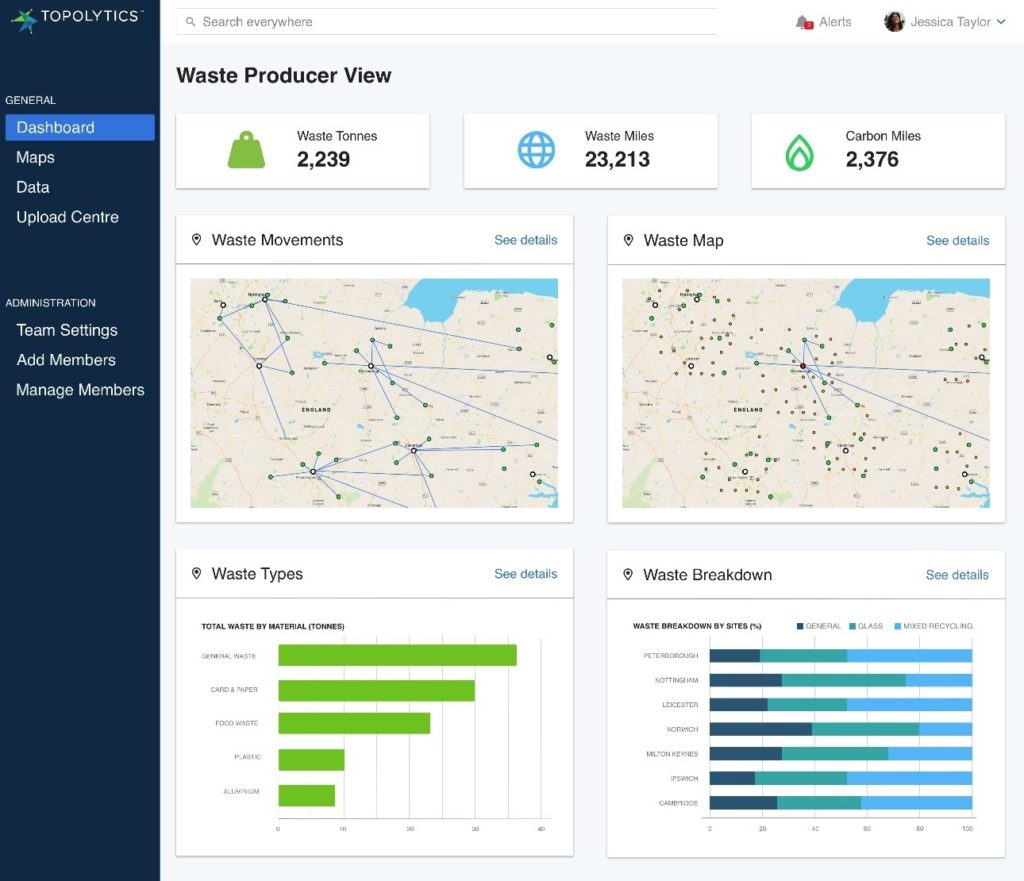
Figure 1: Topolytics Live Waste Mapping Interface (Source: Topolytics 2020)[/caption]
Companies providing more granular data have a range of value propositions across the value chain. Polytag is developing a UV and coded tagging system to trace household recycling using mobile app and visual scanners across the value chain (see Figure 2, below).
Revenue streams can potentially include:
- SaaS subscription for brand owners at different tiers (basic, premium and platinum)
- Access for government bodies and compliance agencies
- The sale of inks and licenses for equipment manufacturers
According to Phil Sutton, Managing Director and Adrià Tarrida, CMO, both at Polytag: “We are initially targeting brands and then Plastic Recovery Facilities (PRF) to close the loop. At PRFs, bails can get downgraded due to contamination. This has created the incentive to separate at a more granular level, instead of turning to the lowest common denominator.”
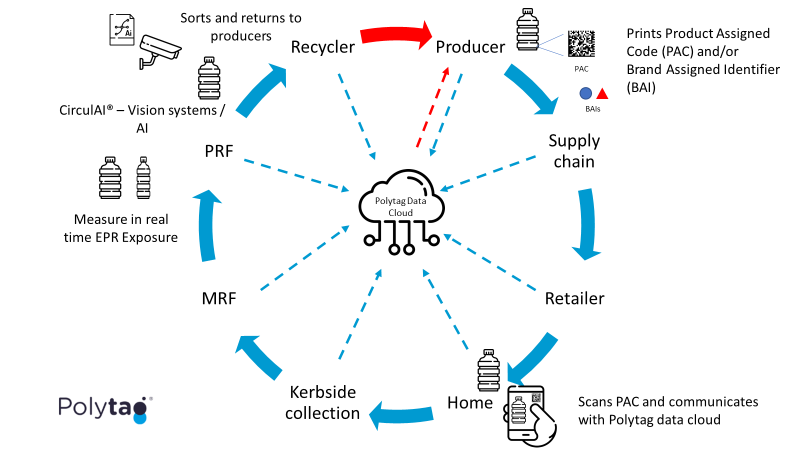
Similarly, Cryptocycle is developing a waste tracking system that uses unique codes, blockchain software (to guarantee against fraud) and smart bin technologies to deliver a deposit return scheme (see Figure 3, below). The system can also scan regular bar codes. Cryptocycle plans to charge drinks manufacturers for the codes in return for recycling statistics; they also have a transaction fee for running the scheme and offer an element of downstream tracking. In March 2020, Cryptocycle started a Reward4Waste household trial. A more comprehensive public trial with a leading recycling organization is scheduled for later this year along with a circular economy World Heritage Site trial due to start in September 2020, subject to Covid-19 disruption. The company is also working with a Reverse Vending Machine (RVM) supplier to integrate its technology to make the RVM cheaper. CTG spoke to Tony McGurk, Founder of Cryptocycle. “We follow the theory that 20% of people will always do the right thing, 20% don’t care and 60% can be incentivised to do the right thing. The Cryptocycle system is designed from the ground up to help change people’s behaviour,” said McGurk.
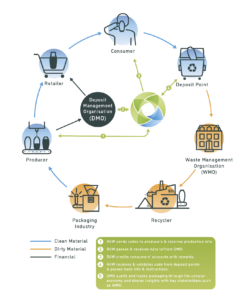
Novel technologies are also emerging. PragmatIC manufactures ultra-low-cost flexible integrated circuits that are at the heart of a new generation of RFID (Radio-Frequency Identification) tags and have the potential to enable trillions of smart objects. PragmatIC’s integrated circuits are using new, non-toxic materials, less water and energy making the tags much less expensive than traditional silicon based tags. In October 2019, PragmatIC partnered with Topolytics and the UK Government to develop the UK’s first digital waste tracking solution. In June 2019, the company also completed a trial with the Tyre Recovery Association (TRA) to successfully tag and track tyres through to end-of life.
We also spoke to Alastair Hanlon, CCO of PragmatIC who said,” Recycled items have value, companies want to track this value and different tracking technologies have pros and cons depending on the use case. At present, PragmatIC is seeing high demand for its low cost RFID integrated circuits as the use of RFID is well understood and there is a lot of infrastructure already available to support it. To give a sense of scale, we have orders in the tens of millions going into large scale trials.”
Competition
At present, most waste analysis is done manually, primarily by consultants and on a one-off basis. Larger scale companies have developed their own tracking systems but these are company-specific. Like many industries, the waste industry is digitizing but the data available is not yet sufficiently detailed or in context (e.g. with consideration of recycled plastic price). Therefore, innovators in the smart waste ecosystem are mostly early stage with grant or seed funding. On a brighter note, the lack of competition in the sector appears to drive collaboration between innovators, helping to advance their technologies even further.
Corporates are also collaborating to implement solutions, as seen in multi-brand associations such as Proctor&Gamble’s Holy Grail 2.0 consortium. P&G are working with technology company Digimarc to implement digital watermarks on products which can then be tracked throughout the value chain. This has been possible thanks to P&G’s position as a market leader with the power and influence to pressure the market to form a consortium.
Competition does, however, exist between corporate consortiums and innovators. For example, Polytag is a direct competitor to Digimarc. But Polytag’s advantage lies in its ability to create recycling data for consumer product groups, governments or recycling compliance agencies, all of which validates EPR policies and reduce its costs.
Some corporates, such as Greenbin, plan to work with corporate partners to develop solutions while others, like Polytag, are working with government partners for a top-down approach to enable greater transparency and accountability features for plastic producers.
Keep an eye on…
Supply chain tracking on all consumer goods is gaining traction. Why? A combination of increased need for proof of origin (for accountability of ESG claims) and catering to the demands of climate-conscious consumers. For my next Sector Insight due out later this month, I will be looking at waste-to-value business models in sustainable fashion and supply chain tracking, where innovators are using RFID tags, threads and software systems.
